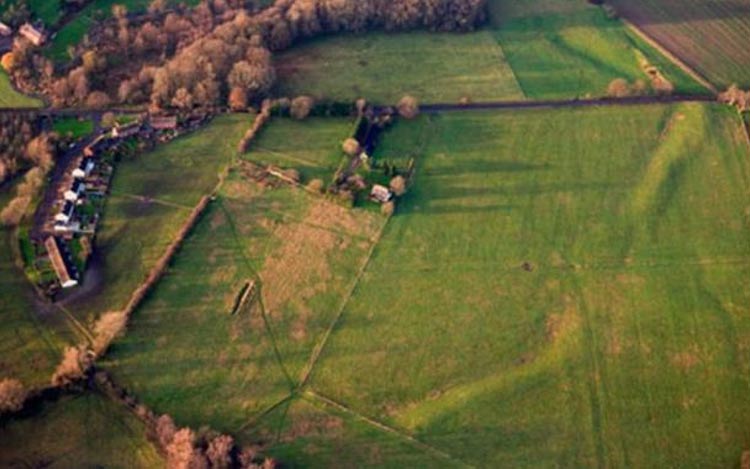Ancient Ceremonial Site 10 Times Bigger than Stonehenge Hits the Archaeological Spotlight
Until recently, Marden Henge was a little known archaeological site, barely visible from the ground and from above. However, recent excavations have thrown this historically important area into the spotlight and archaeologists are now calling it one of the most significant sites in Britain. Researchers are trying to unravel just what prompted the enormous outpouring of time and wealth that went into the creation of Britain’s largest henge.
Marden Henge is a late Neolithic site dating back some 4,500 years, which is located halfway between the World Heritage sites of Stonehenge and Avebury. It consists of giant earthworks that once stood ten feet high and encircled nearly 40 acres of land – ten times the size of Stonehenge.
Lying just a few miles south of Stonehenge, researchers have even suggested that the inhabitants of Marden Henge may have helped to haul the giant stones that make up Stonehenge’s world famous stone circle.
Last month, the University of Reading, in partnership with Historic England, began a three-year excavation of the ancient henge, and they have already made some stunning discoveries.
Researchers unearthed the remnants of a 4,400 year old house at the site, which is thought to be one of the oldest homes discovered in the country, as well as the remains of at least 13 pigs, flint blades, decorated pottery with food residue still preserved within them, copper bracelets, and the remains of a 4,000 year old adolescent who was buried in the fetal position with an amber necklace.
National Geographic reports that they have also now found a stone building that once contained a frequently used fire pit that reached very high temperatures. Researchers have speculated that the it may have served as a place for feasts on a grand scale, where pigs were roasted over a spit. Other interpretations are that the building served as a sweat lodge for special ceremonies, or even the place where people of the Neolithic made first efforts to smelt metal.
- Body of 4,000-year-old teenager near Stonehenge may give clues about Bronze Age lives
- 4,400-year-old ruins found near ceremonial site may be the oldest house ever found in Britain
- Henge of the World

Jim Leary, lead archaeologist, with the remnants of the walls and the floor of the ancient home at Marden Henge. (University of Reading)

The teenager's skull after excavation; scientists hope to determine a lot about the person buried, such as diet, place of habitation, any diseases and cause and year of death. (Daily Mail)
According to the new report in the National Geographic, archaeologists are now looking for clues into what prompted the enormous building boom in Stone Age Britain, which included the construction of Marden Henge, Stonehenge, Avebury, and other great monuments.
“It was insane, utterly unsustainable,” Jim Leary, director of the archaeology field school at the University of Reading, told National Geographic. “We tend to think of people during the Neolithic as somehow being at one with their environment, but they appear to have been just as bad as we are. They were clearing, felling, digging, and consuming their environment at an unsustainable rate in building these huge projects.”
Leary maintains that Marden Henge was too big for any practical purpose, and religious fervor may have played a role, or it may have been to show off power and wealth.
“Certainly something big was going on in this part of Britain during the late Neolithic to have prompted the rash of monument building and outpouring of wealth,” reports National Geographic.

Excavations being carried out near Marden Henge. (Sarah Lambert-Gates/University of Reading)
The excavations at Marden Henge constitute the first serious research at the site since the 1960s. It is hoped that the three year project may provide new insights into the mysterious Neolithic culture that once inhabited the historically rich region around Stonehenge.
Featured image: The site of Marden Henge in Wiltshire (Snip View)




















Comments
Very interesting article. I hope we can find many discoveries that not only shed light on this place but on the connection between all the other sites as well
Peace and Love,
Ricky.
Interesting article – thank you. Very visible monuments like Stonehenge naturally occupy our attention, and it’s great that an important monument that is not quite so visually arresting is getting investigated. I would love other large sites that similarly suffer from lack of ‘exciting’ surface detail to be investigated further such as the Thornborough Henge complex in the North of England.
Sculptures, carvings & artwork inspired by a love of history & nature: www.justbod.co.uk
Interesting statement about consuming the environment at an unsustainable rate building these projects - it's reminiscent of the ideas around what could have happened on Rapa Nui and the Moai building culture.
I was formerly receiving mail at [email protected] and have now changed my email address